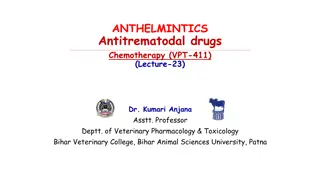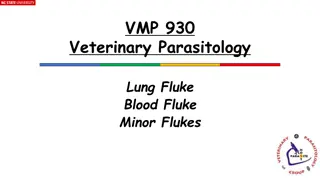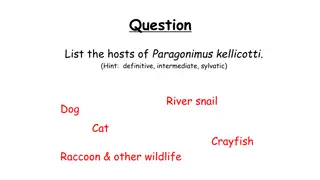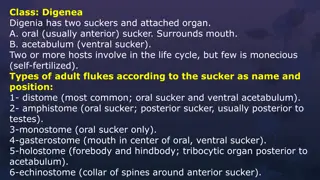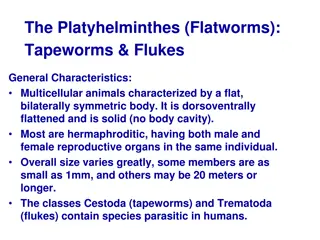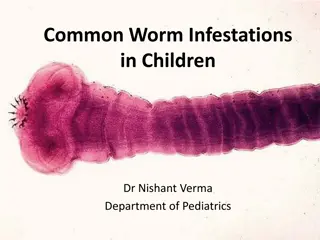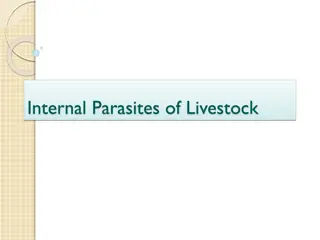Understanding Antitrematodal Drugs and Their Applications in Veterinary Medicine
Fascioliosis caused by F. hepatica is a common concern globally, impacting livestock health and economy. Antitrematodal drugs play a crucial role in combating parasitic infections like fascioliosis. One such drug, Carbon tetrachloride (CCl4), has been effective in treating F. hepatica due to its act
0 views • 33 slides
Understanding Amphistomosis in Ruminants: Causes, Symptoms, and Diagnosis
Amphistomosis is a disease in ruminants caused by several types of rumen flukes. It leads to productivity losses, weight loss, fertility reduction, and other symptoms. Infection occurs through ingestion of contaminated vegetables and raw meat. The parasite affects the rumen and reticulum of sheep, g
0 views • 8 slides
Understanding Lung and Blood Flukes in Veterinary Parasitology
Learn about Paragonimus kellicotti, a lung fluke affecting pets and humans, its life cycle, pathology, diagnosis, and treatment. Explore Heterobilharzia americana, a blood fluke found in dogs along the Gulf Coast States, with unique characteristics and zoonotic implications. Discover the clinical im
0 views • 12 slides
Trematodes and Cestodes: Hosts, Life Cycles, and Diagnostics
Explore the hosts of Paragonimus kellicotti, match flukes with their intermediate hosts, identify flukes causing respiratory signs, learn diagnostic techniques for trematode parasites, and understand the ecological relationship between hosts. Dive into the intriguing world of digenetic trematodes an
0 views • 6 slides
Comprehensive Overview of Blood Flukes: Schistosoma Species
Explore the world of blood flukes, focusing on the Schistosoma species. Learn about their general characteristics, life cycle stages, comparison between different species, and their impact on human health. Discover key aspects such as morphology, hosts, egg characteristics, and how diagnosis of infe
0 views • 12 slides
Anatomy and Biology of Class Digenea Digenia Adult Flukes
Digenea Digenia, a class of parasitic flatworms, have distinctive anatomy and biology. Adult flukes possess two suckers, oral and acetabulum, and exhibit different types based on sucker positioning. Their tegument consists of two zones, with various chemicals for survival. The alimentary tract is in
0 views • 14 slides
Overview of Platyhelminthes: Tapeworms and Flukes
Platyhelminthes, such as tapeworms and flukes, are multicellular organisms with a flat body and hermaphroditic reproductive systems. Tapeworms, a type of Cestode, have a unique structure with a scolex and proglottids for reproduction. They are dioecious and develop through the production of proglott
0 views • 24 slides
Overview of Common Worm Infestations in Children and Neglected Tropical Diseases (NTDs)
Common worm infestations in children, such as Ascaris lumbricoides and Enterobius vermicularis, are a significant health concern globally. Neglected Tropical Diseases (NTDs) like ascariasis, hookworm, and lymphatic filariasis affect millions of people, particularly those in poverty. For just 50 cent
0 views • 25 slides
Understanding Internal Parasites of Livestock
Internal parasites of livestock, such as roundworms, tapeworms, and flukes, can have a significant impact on the health and productivity of animals. These parasites live within the internal organs of livestock, causing various symptoms and affecting different species. Roundworms, like stomach worms,
0 views • 30 slides
